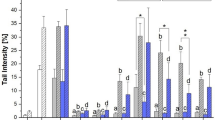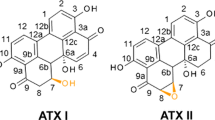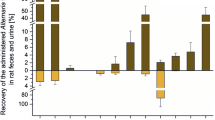Abstract
Toxicity-guided fractionation was used to identify DNA strand breaking impact compounds in extracts obtained from rice heavily infested with the Alternaria alternata strains DSM 62006 and DSM 62010. The major genotoxic potential measured in the comet assay using human colon carcinoma cells (HT29) could be attributed to three unknown peaks, whereas the fractions containing alternariol, its monomethylether or tenuazonic acid showed no significant DNA damaging effects. According to 1H and 13C-NMR spectroscopy, one genotoxic impact compound was identified as Altertoxin II (ATXII). ATXII showed potent DNA damaging properties in HT29 cells with substantial induction of formamidopyrimidine DNA glycosylase (FPG)-sensitive sites. However, no effect was observed with respect to the cellular redox status, measured in the DCF assay and as total glutathione. The induction of apoptosis could be excluded as a potential reason for enhanced DNA damage. After 24 h of incubation with 1 μM ATX II, a significant increase of cells in the G0/G1 phase was observed together with an inhibition of cell proliferation in the sulforhodamine B assay. Taken together, ATX II was found to contribute substantially to the genotoxic effects of complex extracts obtained from Alternaria alternata infested rice. The results demonstrate the high genotoxic potency of ATX II in human cells, underlining the necessity for further studies on the occurrence in food and its relevance for food safety.















Similar content being viewed by others
Abbreviations
- AOH:
-
Alternariol
- ALT:
-
Altenuene
- AME:
-
Alternariol monomethyl ether
- EtAc:
-
Ethyl acetate
- TeA:
-
Tenuazonic acid
References
Barkai-Golan R (2008) Alternaria mycotoxins. In: Barkai-Golan R, Paster N (eds) Mycotoxins in fruits and vegetables, vol 1. Academic Press, Elsevier, Amsterdam, pp 185–203
Barkai-Golan R, Frank M, Kantor D, Karadavid R, Toshner D (1977) Atmospheric fungi in the desert town of Arad and in the coastal plain of Israel. Ann Allergy 38(4):270–274
Benchimol S (2001) p53-Dependent pathways of apoptosis. Cell Death Differ 8(11):1049–1051. doi:10.1038/sj.cdd.4400918
Boutin BK, Peeler JT, Twedt RM (1989) Effects of purified altertoxins I, II, and III in the metabolic communication V79 system. J Toxicol Environ Health 26(1):75–81. doi:10.1080/15287398909531234
Brugger EM, Wagner J, Schumacher DM, Koch K, Podlech J, Metzler M, Lehmann L (2006) Mutagenicity of the mycotoxin alternariol in cultured mammalian cells. Toxicol Lett 164(3):221–230. doi:10.1016/j.toxlet.2006.01.001
Canman CE, Lim DS, Cimprich KA, Taya Y, Tamai K, Sakaguchi K, Appella E, Kastan MB, Siliciano JD (1998) Activation of the ATM kinase by ionizing radiation and phosphorylation of p53. Science 281(5383):1677–1679
Coste F, Ober M, Carell T, Boiteux S, Zelwer C, Castaing B (2004) Structural basis for the recognition of the FapydG lesion (2,6-diamino-4-hydroxy-5-formamidopyrimidine) by formamidopyrimidine-DNA glycosylase. J Biol Chem 279(42):44074–44083. doi:10.1074/jbc.M405928200
Davis VM, Stack ME (1991) Mutagenicity of stemphyltoxin III, a metabolite of Alternaria alternata. Appl Environ Microbiol 57(1):180–182
Dong ZG, Liu GT, Dong ZM, Qian YZ, An YH, Miao JA, Zhen YZ (1987) Induction of mutagenesis and transformation by the extract of Alternaria alternata isolated from grains in Linxian, China. Carcinogenesis 8(7):989–991
Fehr M, Pahlke G, Fritz J, Christensen MO, Boege F, Altemoller M, Podlech J, Marko D (2009) Alternariol acts as a topoisomerase poison, preferentially affecting the II alpha isoform. Mol Nutr Food Res 53(4):441–451. doi:10.1002/mnfr.200700379
Fleck SC, Burkhardt B, Pfeiffer E, Metzler M (2012) Alternaria toxins: Altertoxin II is a much stronger mutagen and DNA strand breaking mycotoxin than alternariol and its methyl ether in cultured mammalian cells. Toxicol Lett 214(1):27–32. doi:10.1016/j.toxlet.2012.08.003
Griffin GF, Chu FS (1983) Toxicity of the Alternaria metabolites alternariol, alternariol methyl ether, altenuene, and tenuazonic acid in the chicken embryo assay. Appl Environ Microbiol 46(6):1420–1422
Hartman PE, Suzuki CK, Stack ME (1989) Photodynamic production of superoxide in vitro by altertoxins in the presence of reducing agents. Appl Environ Microbiol 55(1):7–10
Johnson DG, Walker CL (1999) Cyclins and cell cycle checkpoints. Annu Rev Pharmacol Toxicol 39:295–312. doi:10.1146/annurev.pharmtox.39.1.295
Keston AS, Brandt R (1965) Fluorometric analysis of ultramicro quantities of hydrogen peroxide. Anal Biochem 11(1):1–5
Lehmann L, Wagner J, Metzler M (2006) Estrogenic and clastogenic potential of the mycotoxin alternariol in cultured mammalian cells. Food Chem Toxicol 44(3):398–408. doi:10.1016/j.fct.2005.08.013
Liu GT, Qian YZ, Zhang P, Dong WH, Qi YM, Guo HT (1992) Etiologic role of Alternaria-Alternata in human esophageal cancer. Chinese Med J-Peking 105(5):394–400
Pelka J, Gehrke H, Esselen M, Turk M, Crone M, Brase S, Muller T, Blank H, Send W, Zibat V, Brenner P, Schneider R, Gerthsen D, Marko D (2009) Cellular uptake of platinum nanoparticles in human colon carcinoma cells and their impact on cellular redox systems and DNA integrity. Chem Res Toxicol 22(4):649–659. doi:10.1021/tx800354g
Pero RW, Posner H, Blois M, Harvan D, Spalding JW (1973) Toxicity of metabolites produced by the “Alternaria”. Environ Health Perspect 4:87–94
Pfeiffer E, Eschbach S, Metzler M (2007) Alternaria toxins: DNA strand-breaking activity in mammalian cells in vitro. Mycotoxin Res 23(3):152–157. doi:10.1007/bf02951512
Schrader TJ, Cherry W, Soper K, Langlois I (2006) Further examination of the effects of nitrosylation on Alternaria alternata mycotoxin mutagenicity in vitro. Mutat Res 606(1–2):61–71. doi:10.1016/j.mrgentox.2006.02.008
Schwarz C, Kreutzer M, Marko D (2012) Minor contribution of alternariol, alternariol monomethyl ether and tenuazonic acid to the genotoxic properties of extracts from Alternaria alternata infested rice. Toxicol Lett. doi:10.1016/j.toxlet.2012.08.002
Scott PM, Kanhere SR (2001) Stability of Alternaria toxins in fruit juices and wine. Mycotoxin Res 17:9–14
Solfrizzo M, De Girolamo A, Vitti C, Visconti A, van den Bulk R (2004) Liquid chromatographic determination of Alternaria toxins in carrots. J AOAC Int 87(1):101–106
Song K, Kelso C, de los Santos C, Grollman AP, Simmerling C (2007) Molecular simulations reveal a common binding mode for glycosylase binding of oxidatively damaged DNA lesions. J Am Chem Soc 129(47):14536. doi:10.1021/Ja075128w
Stack ME, Mazzola EP (1989) Stemphyltoxin III from Alternaria alternata. J Nat Prod 52(2):426–427
Stack ME, Prival MJ (1986) Mutagenicity of the Alternaria metabolites altertoxins I, II, and III. Appl Environ Microbiol 52(4):718–722
Stack ME, Mazzola EP, Page SW, Pohland AE, Highet RJ, Tempesta MS, Corley DG (1986) Mutagenic perylenequinone metabolites of Alternaria alternata: altertoxins I, II, and III. J Nat Prod 49(5):866–871
Tice RR, Agurell E, Anderson D, Burlinson B, Hartmann A, Kobayashi H, Miyamae Y, Rojas E, Ryu JC, Sasaki YF (2000) Single cell gel/comet assay: guidelines for in vitro and in vivo genetic toxicology testing. Environ Mol Mutagen 35(3):206–221
Tietze F (1969) Enzymic method for quantitative determination of nanogram amounts of total and oxidized glutathione: applications to mammalian blood and other tissues. Anal Biochem 27(3):502–522
Wardman P (2007) Fluorescent and luminescent probes for measurement of oxidative and nitrosative species in cells and tissues: progress, pitfalls, and prospects. Free Radical Bio Med 43(7):995–1022. doi:10.1016/j.freeradbiomed.2007.06.026
Wardman P, Burkitt MJ, Patel KB, Lawrence A, Jones CM, Everett SA, Vojnovic B (2002) Pitfalls in the use of common luminescent probes for oxidative and nitrosative stress. J Fluoresc 12(1):65–68
Wollenhaupt K, Schneider F, Tiemann U (2008) Influence of alternariol (AOH) on regulator proteins of cap-dependent translation in porcine endometrial cells. Toxicol Lett 182(1–3):57–62. doi:10.1016/j.toxlet.2008.08.005
Zhen YZ, Xu YM, Liu GT, Miao J, Xing YD, Zheng QL, Ma YF, Su T, Wang XL, Ruan LR (1991) Mutagenicity of Alternaria alternata and Penicillium cyclopium isolated from grains in an area of high incidence of oesophageal cancer-Linxian, China. IARC Sci Publ 105:253–257
Author information
Authors and Affiliations
Corresponding author
Rights and permissions
About this article
Cite this article
Schwarz, C., Tiessen, C., Kreutzer, M. et al. Characterization of a genotoxic impact compound in Alternaria alternata infested rice as Altertoxin II. Arch Toxicol 86, 1911–1925 (2012). https://doi.org/10.1007/s00204-012-0958-4
Received:
Accepted:
Published:
Issue Date:
DOI: https://doi.org/10.1007/s00204-012-0958-4




